- Home
- About S&T
- Taxa/Organisms
- Ecosystems
- Issues
- Methods & Tools
- Reports & Publications
- Location
- Search
Publisher: USGS | Science Center: Florida Integrated Science Center (FISC, Gainesville) | Format: URL
fl.biology.usgs.gov — The connection between fish habitat utilization, prey use, and fish movement patterns is not known in relation to available invertebrate prey resources in off-reef sites. Developing a better understanding of the habitat use, diet, and resource needs of benthic communities and their interactions with mobile fish and invertebrates is an important More...
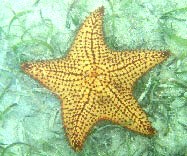
Publisher: USGS | Science Center: Florida Integrated Science Center (FISC, Gainesville) | Format: URL
fl.biology.usgs.gov — The Nile tilapia (Oreochromis niloticus) is commonly used in aquaculture worldwide. Feral populations exist in many regions where individuals escape culture and establish in natural habitats. In Mississippi, Nile tilapia are established in at least three distinct localities (fig. 1): the lower Pascagoula and Escatawpa river drainages, and a More...

Publisher: USGS | Science Center: Florida Integrated Science Center (FISC, Gainesville) | Format: URL
fl.biology.usgs.gov — Because the African jewelfish has a broad salinity tolerance, scientists tested how the species low-temperature tolerance varied at three salinities: freshwater (0 ppt), brackish (10 ppt) and marine (35 ppt) in the laboratory. A field experiment was then conducted to examine the survivorship of individuals when caged in several common aquatic More...
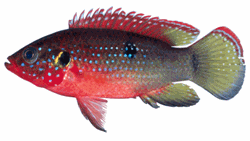
Publisher: USGS | Science Center: Forest and Rangeland Ecosystem Science Center (FRESC, Corvallis) | Format: URL
fresc.usgs.gov — This dataset is an ArcInfo point coverage depicting obstacles to anadromous fish migration in western Oregon. Data were compiled by fourth-field hydrologic unit code (HUC) from the Oregon Department of Fish and Wildlife StreamNet Database and from reports by fisheries biologists in various management agencies. Both natural and constructed (e.g., More...

Publisher: USGS | Science Center: Northern Rocky Mountain Science Center (NRMSC, Bozeman) | Format: URL
nrmsc.usgs.gov — This research project examines dispersal and several components of fitness between hybrids and non-hybridized fish. Further, scientists will examine the relationship between environmental factors and genetic and demographic characteristics of hybrid populations. The specific objectives are: (1) to compare the spawning dynamics and dispersal More...
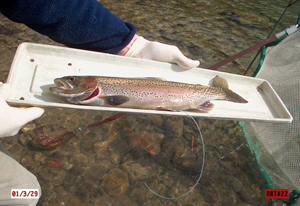
Publisher: USGS | Science Center: Florida Integrated Science Center (FISC, Gainesville) | Format: URL
fisc.er.usgs.gov — Visual surveys of underwater reef fish overlook the hidden, cryptic fish that comprise most of the diversity and numerical abundance of coral reef habitats. Research by Smith-Vaniz, Jelks, and Rocha shows how rotenone revealed cryptic fish in a survey of fish August-September 2001 at Buck Island Reef National Monument, St. Croix, U.S. Virgin More...

Publisher: USGS | Science Center: Biological Informatics | Format: URL
biology.usgs.gov — This page presents samples of genetics and genomics research from the USGS Biological Resources Discipline about the conservation genetics of fish.
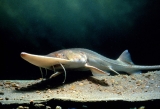
Publisher: USGS | Science Center: Western Fisheries Research Center (WFRC, Seattle) | Format: URL
wfrc.usgs.gov — Bacterial kidney disease (BKD) is caused by Renibacterium salmoninarum and is considered to be the most difficult salmonid bacterial disease to control, in part because of its dual modes of transmission. This bacterium, unlike most other fish pathogens, is transmitted vertically from parent fish to progeny in association with the eggs, as well as More...

Publisher: USGS | Science Center: Alaska Science Center (ASC, Anchorage) | Format: URL
www.absc.usgs.gov — Genetics of Alaska Fishes Projects studies include comparing molecular genetics for rainbow trout throughout their range in Alaska and use microsatellite analyses to look at hatchery and wild populations of steelhead in the Snake River (Phylogeographic analysis of rainbow trout in Alaska). Research also looks at genetic population structure of More...

Publisher: USGS | Science Center: Western Fisheries Research Center (WFRC, Seattle) | Format: URL
wfrc.usgs.gov — This study will compare relative abundance, population structure, and spawning success of desert pupfish from natural (reference) and manmade or disturbed habitats in the Salton Sea basin. In addition, this study will determine the importance of fish predation as a source of mortality in desert pupfish populations. Finally, this study will attempt More...
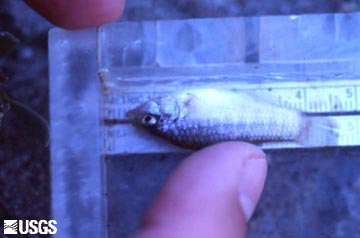
Publisher: USGS | Science Center: Western Fisheries Research Center (WFRC, Seattle) | Format: URL
wfrc.usgs.gov — As anadromous juvenile salmonids migrate from freshwater rearing habitats to the ocean, they are vulnerable to a host of factors that affect their survival. Direct effects associated with dam passage (e.g., instantaneous mortality, injury, loss of equilibrium, etc.) and indirect effects (e.g., predation, disease, and physiological stress) More...

Publisher: USGS | Science Center: Western Fisheries Research Center (WFRC, Seattle) | Format: URL
wfrc.usgs.gov — As anadromous juvenile salmonids migrate from freshwater rearing habitats to the ocean, they are vulnerable to a host of factors that affect their survival. Direct effects associated with dam passage (e.g., instantaneous mortality, injury, loss of equilibrium, etc.) and indirect effects (e.g., predation, disease, and physiological stress) More...
